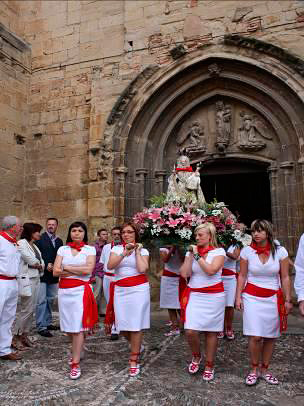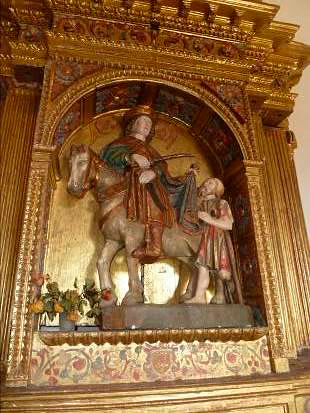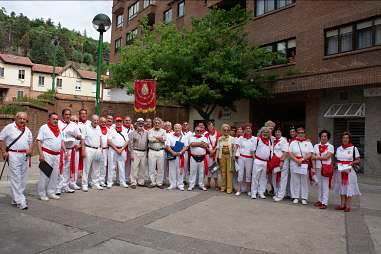26 September
Global Seminars & Invited Speaker Series
VIANA ON ITS VIII CENTENARY: CULTURE AND HERITAGE
Viana: historical and social singularities
Félix Cariñanos San Millán
Ethnographer and historian
On examining the archives of Viana, the intangible heritage of this town and the life in its streets throughout history, the researcher website reveals that there are two peculiarities that stand out from many other towns in Navarre: its location on the border of the former Castile - now the autonomous community of La Rioja - and its inclusion until 1956 in the diocese of Calahorra and La Calzada.
Both circumstances are still evident today, both in the incorporation in modern times to the Rioja Qualified Designation of Origin, longed for by our winemakers at least since the end of the 18th century, and in the numerous monumental and artistic traces of influences from Burgos, Herrera and La Rioja due to the artists who came from outside Navarre.
One of these heritage features is the originality of its different festivals. The festival of San Felices or of the Foundation stands out, in which submission gives each schoolchild a coin to remind them that this city was born on 1 February 1219. It is a civil event that has been recorded as part of the city's heritage, that is, that of the City Council.
The festivity of Saint Mary Magdalene, Sole Patron Saint of the town since the plague of 1599 according to the repeated definition of the corporations, was always zealously led by them, without allowing interference from the local ecclesiastical authority. In 1973, the wine of honour that the councillors and guests were given in the meeting hall was moved to the arcades of the town hall and gave rise to the tasting known as the " pasta de la Magdalena".
Unlike the public civil authorities, the young men created a new festival from 1876, that is, after the end of the Third Carlist War. This repeated another singularity of the town's festivities: its way of recovering its spirit, century after century, despite the struggles and difficulties of agricultural life. The young people organised themselves into numerous societies and groups, the seed of the future peñas of the 20th century, one of the most important of which was the chunchún, an official parade in which the young men and women, in front of the Town Hall procession, took possession of the giants and set the rhythm of the march to the cows and back from the place del Coso.

Bearers of the Virgin of Nieva. 2009.
The festivities of the Virgen de Nieva - a Segovian devotion - or of Thanksgiving were the biggest until the times of industrialisation; they always hosted more events and days than those of July and were totally dominated by the mozería. Unlike the Magdalen festival, which was known as the feast of the rich, these were known as the feast of the poor. The lexical distinction was based on the fact that the former took place in harvest time and the day labourers did not receive any money, while in September the harvest had already been harvested.
A subject as substantial as the food is revealed in traditional dishes that adapt to the different agricultural seasons: el rancho del trujal at olive milling, el rancho mil chorras at wine racking, la cabbage with snails and meat for Saint Martin's Day, la cena de las habas de la Cofradía de la Soledad for Maundy Thursday... This is an abundantly documented topic , which allows us to divide the different types of refreshments into those served by the Town Councils and those practised by the people.
The council frequently gives gifts to viceroys and personalities who can bring it benefits. The products of the land are used when the councillors eat in the countryside when carrying out demarcations together with councillors from other localities. Also noteworthy are the refreshments that are allowed in the Balcón de Toros - a place where women are usually forbidden access - while they attend bullfighting shows.
The town was helped in times of famine, especially in the winters, hence the creation in 1898 of the Economic Kitchen, maintained by the Town Council, the parish and some of the town's prominent figures. The popular meals were based on the "ranchos entre cuadrillas" and the "puchero de campo", the comfort of the day labourers. For centuries, the frying pans frequented by the shepherds from Viana, Navarre and La Rioja of wild cattle from the Ribera region of Navarre and La Rioja along the Ebro in the Galindo and Valdegón groves were a daily occurrence.
The fairs and markets were also a feature of the frontier. These are already mentioned in the regional law del Águila, granted by Sancho VII el Fuerte. Both the medieval kings of Navarre and Ferdinand the Catholic and Charles I took care to respect these privileges. At the end of the 18th century, the Viana corporations, aware of their proximity to Castile, tried to extend the eleven days of the fair to twenty-five, or even fifty-nine, in order to sell wine, eau-de-vie and oil better. The fairs lasted until 1904 and the current market on Fridays in the Coso succeeded those prosperous and local markets at the end of the 19th century.
In the end, a good handful of those significant secular manifestations survive today, sown in different fields:
- The pilgrimages to Shrine of Our Lady of Fair Love de Cuevas, a place named in the Codex Calixtinus that hosts the Easter Monday and 7 and 8 September pilgrimages of its 1,800 members, with the sharing of bread and wine in the latter.
- The pilgrimages to the Shrine of Our Lady of Fair Love of San Martín de Tidón on the last Saturday in May - with the distribution of muscatel wine and pastries - and on 11 November.

San Martín de Tidón. 16th century.
- The four blessings of the fields from the walls in procession to San Isidro Labrador.
- The oral tradition preserved even about witches in the 20th century (la Coletilla, la Chichota), without forgetting the most singular portrait of the Witch of Bargota drawn by the pen of Francisco Navarro Villoslada in his unfinished novel El hijo del Fuerte (The Son of the Fort).
- The strength of the new municipal band (2004); the bagpipers (2016); the charanga Gazte-berri, successor (1914) of the mythical Miracueto; the comparsa de gigantes y cabezudos (1886); and the dances of Erentzun Ikastola.
- The auroros, Pedro Angulo Rozas "Periquillo", shepherd, revivalists of traditional folklore.

Auroros de Viana Choir at the Casa de los Navarros in Burgos. 2007.
- The murguistas, successors of those who maintained the carnival murga in the 19th century, the post-war period and the beginnings of industrialisation.
- The joteros, some of them improvisers of sudden or instantaneous jotas.
- The evocations of César Borgia, compiled by Juan de Amiax, José de Alesón, Francisco Navarro Villoslada and those who saw him exhumed in 1885 and 1945 and buried in 1953.
There are many more aspects that could be listed, but that is enough. Welcome to Viana, and enjoy it.
